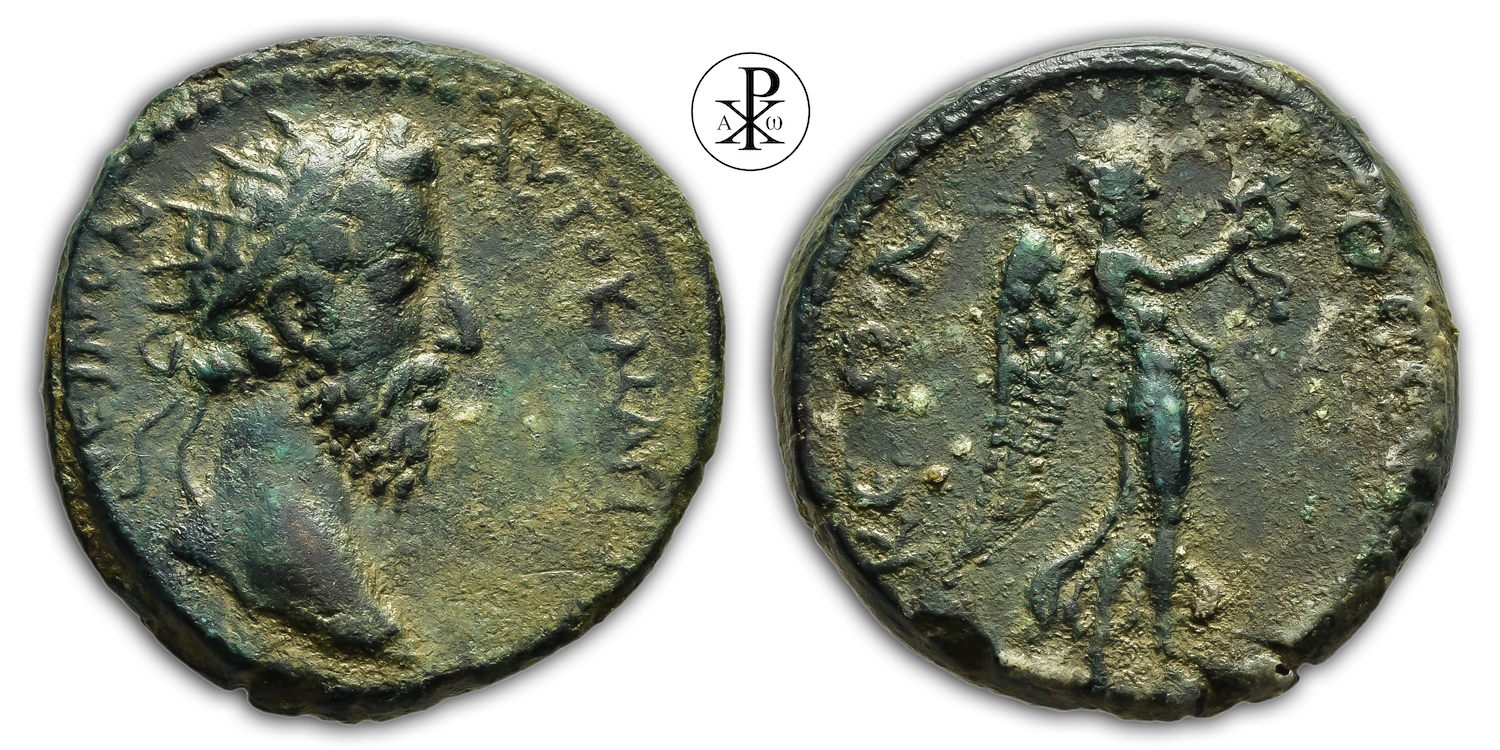Imperator Caesar Marcus Aurelius Commodus Antoninus Augustus
Reign: Commodus
Mint: Thessalonica, Macedonia
Date: 180/192 AD
Nominal: Bronze
Material: AE
Diameter: 26mm
Weight: 13.32g
Reference: RPC IV.1 25008 (this coin)
RPC Online: https://rpc.ashmus.ox.ac.uk/coins/4/25008
Rare: Specimens 1 (0 in the core collections)
Provenance: Numisfitz Numismatik Munich, Germany (Auction 1, Lot 467)
Pedigree: –
Special: Only known example, RPC Online Plate coin
Obverse: Radiate head of Commodus, right
Inscription: ΑΥΤoΚ Μ ΑΥΡ [ΚΟΜΜ ΑΝΤΩΝ]ƐΙΝoΝ
Translation: Autokrator Marcos Aurelios Kommodos Antoneinon
Translation: Imperator Marcus Aurelius Commodus Antoninus
Reverse: Nike advancing, right, holding wreath and palm-branch
Inscription: ΘƐϹϹΑΛΟΝΙΚƐΩΝ
Translation: Thessalonikeon
Translation: City and People of Thessalonica
Comment: Thessaloniki was founded in 315 BC by the Macedonian king Kassandros as Thessalonikē by merging 26 smaller towns on the site of Therme on the Thermaic Gulf, originally a Thracian settlement and named after his wife Thessalonikē, a half-sister of Alexander the Great. The name Thessalonikē commemorated the conquest of Thessaly by Macedonia (Thessalonikē, ‘victory in Thessaly’, to ancient Greek νίκη nikē ‘victory’) under Philip II (359 to 336 BC). In 168 BC, the Romans abolished the Macedonian kingship and made Macedonia, with Thessalonica, a province of their empire in 146 BC. Thessalonica was situated on the Via Egnatia, the main traffic route between Rome and Byzantium, and on the Balkan road leading north. It became the capital of the Roman province of Macedonia. In 58 BC, Cicero went into temporary exile here. After fleeing Italy from Caesar in 49 BC, the consuls moved their quarters to Thessalonica. About 200 senators accepted their invitation. They declared the meeting place to be Roman state soil so that senate meetings could be held. Around 49 or 50 AD, the Apostle Paul stayed in Thessalonica on his second missionary journey and founded the second named Christian community in Europe after Philippi. A few years after 260 AD, attacks by the Goths were repelled by the city.
Around 300 AD, under Emperor Galerius, Thessaloniki became one of the imperial residences of the Roman Empire and was equipped with important buildings, including the following with the imperial palace, the horse-racing track (Hippodrome) parallel to the palace, the Arch of Galerius (victory monument of Emperor Galerius next to the Via Egnatia, erected on the occasion of a victory over the Sassanids), the Rotunda (perhaps a mausoleum or pantheon) and the Forum, as well as an Agora (pillars with magnificent relief figures from a two-storey hall is now in the Louvre, Paris) with an Odeion. In 322 AD, Emperor Constantine I (the Great) had an artificial harbour basin built at the southwest corner of Thessaloniki. In 325 AD Licinius (co-emperor from 308 to 324 AD) was executed in Thessalonica. As a result, Constantine finally became sole ruler (totius orbis imperator); on 11 May 330 AD, Byzantium finally became the Christian imperial capital (Second Rome) and was renamed Constantinopolis a little later. The period in which Thessaloniki had been the imperial residence thus came to an end. In 390 AD, Thessaloniki experienced an uprising against Emperor Theodosius I, which he had bloodily put down in the so-called Massacre of Thessaloniki. After the division of the empire in 395 AD, Thessaloniki belonged to the eastern part of the empire under Emperor Arcadius and his successors.
Nike is the goddess of victory in Greek mythology. Her Roman equivalent is Victoria. Coins depicting Nike recall the founding name of Thessalonikē through the conquest of Thessaly by Macedonia (victory in Thessaly) – and have been a frequent motif of city coinage.
